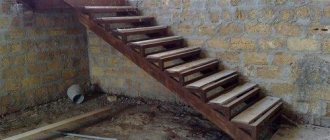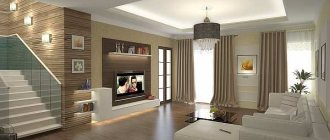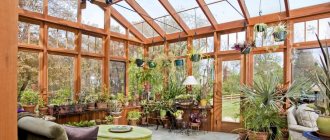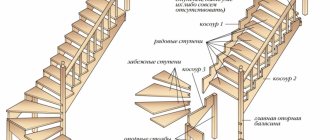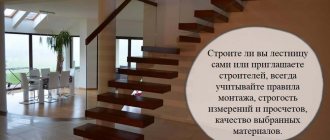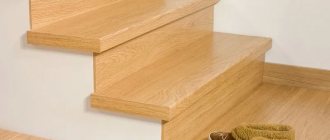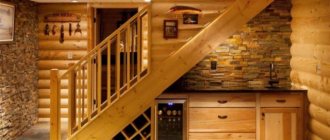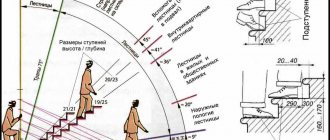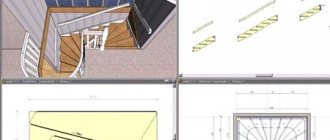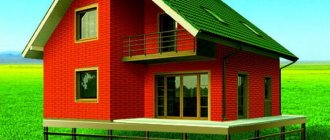For example, the length of one span is five meters, and the optimal step height, as is known, does not exceed twenty centimeters. Based on the above formula, we make a calculation and get the required number of steps:
Often, in order to save land on a site, two-story houses are built. And the main task of the developer in this case is the correct design of the rooms inside the premises, but the selection and installation of the staircase that will lead to the second floor falls entirely on the shoulders of the owner of the building. That is why many are trying to find out which staircase takes up as little space as possible, since in most cases the area of each individual room in a private house leaves much to be desired.
If you also need a practical, convenient and, most importantly, safe staircase with compact dimensions, you can immediately discard the options with a straight flight and turns of 90 or, especially, 180 degrees. An excellent solution in your situation would be to purchase and install a metal staircase. These could be, for example, prefabricated (modular) stairs.
The prefabricated metal spiral staircase is great for small spaces and looks aesthetically pleasing
If you make a staircase on wooden beams, it will merge with the wall into an acoustically single structure, which means your steps will be clearly heard throughout the house.
Compact marching design
It is believed that flight stairs are the most convenient and safest design for climbing. However, it can take up quite a lot of space.
Such a structure consists of straight steps running one after another, the optimal parameters of which will not always help save space.
In addition, the dimensions of the staircase itself often “eat up” the usable area. How much space the structure will take up largely depends on its angle of inclination. The smaller it is, the more space will be required for its construction. For example, a tilt angle of 25 degrees will require the construction of a structure more than six meters long, which clearly does not lead to space savings.
However, there is a way out: if there is little space, you can make a staircase with your own hands with a 90-degree turn.
Typically, such a structure on the second floor is built against the wall, which leads to saving living space. A platform may be required to turn, but if you want to make the staircase even more compact, you can replace it with winder steps. It’s worth warning right away that creating them with your own hands is much more difficult than straight ones, since they have a special shape in the form of a trapezoid.
So, which ones to choose? It is very important to choose the right design for the future staircase.
Structural features of spiral staircases
The steps of circular staircases are fixed either to a central pillar or to railings and bowstrings. The last option looks exclusive, but has complex installation. Also, such a system takes up significantly more space than the first option. If you plan to do the construction yourself, it is better to build a structure that is attached to a mounting pole.
In order for the upward lift to be comfortable, for a device that is located near the wall and in the corners, you need to choose a convenient spiral direction - clockwise or counterclockwise. When making calculations, in both cases it is necessary to take into account the distance that will be needed for the railings and fencing.
Such a staircase has a number of nuances
Before starting construction work, the following parameters must be taken into account:
- the width of the upper opening in the ceiling must be at least 2 meters;
- the length of the steps is assumed to be at least 90 centimeters;
- the minimum distance between the handrails of the railing and the edge of the upper edge can be 10 centimeters; the distance to the wall should be similar.
Small stairs to the second floor
So, which ones to choose? It is very important to choose the right design for the future staircase.
Small stairs include:
- Folding;
- Non-standard one-march;
- Marching, but with platforms;
- Screw.
If the second floor is rarely used, for example, as an attic or warehouse, then it is not necessary to install a full-fledged staircase for this purpose. For a long time there have been folding structures that can be hung from the lid or ceiling. It folds up easily, so it won’t interfere with anyone.
Sliding stairs also have different types:
- Retractable;
- Folding;
- Sectional;
- Telescopic.
It is clear that such designs do not provide for the presence of railings, but they are often equipped with handrails.
Single-flight staircases are the largest. To save space, designers and planners use various non-standard moves, for example, narrowing the treads in turn on each side. This makes the staircase smaller but still comfortable and safe.
The staircase frame can be made of various materials, and you can decorate the staircase and make it interesting by finishing the steps with wood. For more information on how to do this, read the material: https://homeli.ru/remont-i-otdelka/lestnitsy/otdelka-lestnitsy-derevom.
A staircase becomes necessary when building a second floor or mezzanine, arranging additional rooms, and also building a summer house. A staircase always turns out to be comfortable if you set aside an area for it when creating a house project. But if you make repairs or redevelopment, and insert a staircase into an already finished room, this often reduces its convenience.
A staircase becomes necessary when building a second floor or mezzanine, arranging additional rooms, and also building a summer house. A staircase always turns out to be comfortable if you set aside an area for it when creating a house project. But if you make repairs or redevelopment, and insert a staircase into an already finished room, this often reduces its convenience.
For ease of use of the staircase, there are certain construction standards that require each element to be “adjusted” to. For example, the main march should have a slope of thirty to forty degrees. The steps should not be narrower than 270 millimeters. The riser must have a minimum height of twenty centimeters. The height of the railing should be at least ninety centimeters. Balsins should be separated by ten to fifteen centimeters.
Here's what often helps make a staircase more compact:
The selection of the level of steps is also important - for schoolchildren and pensioners it will be difficult to constantly climb the higher ones. To increase the safety of the structure, cover the staircase with a carpet. This will look stylish and will avoid the problem of “slippery floors”.
Types of stairs for small rooms
Today there are a large number of models of small stairs, each of which has both advantages and disadvantages of operation. The choice of design is influenced by the dimensions of the staircase opening, its shape, width, length and height. The final result of the styling depends on the correct calculation of these parameters.
In conditions of limited space, an excellent solution would be to install the following models of small stairs to the second floor:
- Screw. These are unsafe structures of the original form. Not suitable for homes with elderly people and small children.
- Rotary. They provide maximum space savings - they are often ordered for two-level apartments.
- Modular. They are in great demand due to their unusual shape and stylish design; expensive materials are often used for their production.
- Attached. Outwardly they resemble stepladders and are very unstable structures.
- "Goose step" A distinctive feature of such models is that you can stand on them with only one leg.
- Attic. Their main disadvantage is the need to constantly clean up the structure for the next use.
It is important to take into account the shape of the staircase opening - a screw design is suitable for round and square ones; for a narrow opening, a small L-shaped staircase to the second floor is best suited.
If safety is most important to you, then we recommend paying attention to U-shaped stairs - they are the most comfortable to use, although they take up quite a lot of space.
On the video: the main types of stairs.
Wooden
A variety of materials can be used to make such structures, but wood is still in great demand. A wooden staircase in a small country house not only serves as an important stylistic element of the room, but also allows you to save space in adjacent rooms.
Stairs made of natural wood are popular due to the undoubted advantages of this traditional building material:
- environmental friendliness;
- durability;
- ease of processing;
- reliability;
- variety of wood species.
The best option is to place the staircase structure in the center of the living room or dining room, so it will take up minimal space and fit seamlessly into any design. It is important that the color scheme of the staircase is combined with the overall design, and that the steps are comfortable for movement.
A wooden staircase is perfect for a small opening and is the safest version among the popular small-sized models.
If you plan to make the base of the staircase structure yourself, then pay attention to the metal frame (on top of which a wooden sheet is placed). Even a novice master can easily perform this option. And treads lined with wood retain heat for a long time and give a feeling of comfort.
Related article: Design features of a living room with a staircase and design ideas |+76 photos
Modular
Modern technologies make it possible to create the most incredible designs. This rule applies to a greater extent to modular stairs. Such models in a small space look unusual, even extravagant due to their unique assembly and allow you to “play” with space.
The advantage of such models is the possibility of self-installation, depending on the chosen form. Thus, a modular staircase can have a right angle or an inclination of 180 degrees, be spiral-shaped, screw-shaped, rounded or L-shaped. In this case, the opening parameters do not matter much - such stairs can be installed in long, narrow, short and wide niches.
Improperly designed staircases pose a huge danger to home occupants, especially for modular staircases used in confined spaces. Take a responsible approach to choosing a construction company; it is better to entrust such a matter to professionals to avoid problems in the future.
Remember that steep stairs are not safe for children and people with disabilities.
Experts highlight several basic tips for choosing modular stairs for small spaces (living rooms, corridors, dining rooms):
- To determine the size of the structure, you need to measure the area of the room and take measurements of the opening (into which the staircase will subsequently be installed).
- A simple modular design is very unsafe; during the construction process, the stairs should be equipped with protective railings.
- For more convenient movement on sharp turns, we recommend paying attention to stairs without risers (such models are easy to install and comfortable).
- When choosing a design design, do not forget about the color balance and stylistic unity of the room, especially when it comes to the design of living rooms.
The staircase in small rooms (in two-level apartments) should first of all be safe, and then beautiful and easy to use. Compact turns will be an excellent addition to a narrow opening, solve the problem of zoning rooms and at the same time save a lot of space in the house. This option is optimal for quickly moving between floors, although the narrow steps cannot be called safe.
Related article: Making a metal staircase with your own hands (assembly guide)
Safe
The main danger of small-sized structures is the presence of narrow steps and sharp turns. That is why the choice of this interior element should be approached with special responsibility. It is important to take into account the factor of “compliance with dimensions and parameters” - this determines the safety of stairs in small rooms. The dimensions of the flights of stairs should be the same, and the railings should not be too high.
Another important point when choosing a staircase is the slope of the steps, because a strong deviation in one direction or the other can lead to a fall. To improve the safety of modular turns, special standards have been developed. Compliance with them will help avoid accidents.
Safety standards for selecting small structures:
- The optimal vertical distance from the surface of the steps to the ceiling should not be less than two meters (this rule does not apply to attic models).
- Pay attention to the length of the opening - upon completion of all work, the structure should not interfere with normal movement between the first and second floors.
- The minimum opening width is 60 centimeters. Make sure that the staircase matches this indicator.
- Discomfort may arise as a result of incorrectly selecting the height of the steps.
Sometimes compact designs make the room even more uncomfortable, taking up an already limited space. If there is no space in the apartment for arranging a staircase turn, then it is worth thinking about the location of the external staircase in the side niche.
Over many years of practice, builders have discovered one simple truth - the larger the staircase opening, the more convenient it is to move between floors and rooms, and vice versa.
The main problem with small openings is the need to constantly bend down to move from one room to another. Therefore, if you are just planning the construction of a country house or a major renovation of an apartment, then do not skimp on space for arranging the stairs. This will protect you from problems with choosing a suitable design in the future. And do not forget that the main criterion in this case is not external attractiveness, but safety.
Mistakes in designing stairs in a wooden house (1 video)
Design solutions for small-sized houses (52 photos)
Criterias of choice
When installing a staircase for small openings in a country house or country house, first of all you need to pay attention to the design features of the selected model. Before ordering, it is recommended to consult with a specialist, taking into account not only the style of the interior, but also the factors that determine the convenience of the subsequent use of the staircase.
Such criteria include:
- Small dimensions - the dimensions of the structure must correspond to the area of the room, especially in limited space.
- Convenience - non-slip material of the steps, suitable height of the railings.
- Safety - use of high-quality materials and compliance with installation rules.
The choice of a small-sized staircase should be approached with special responsibility. It is necessary to take into account the wishes of all residents and the features of the building. If there are small children in the house, then the option without railings will be very inappropriate. It is also worth refusing to use steep structures, because a child may inadvertently trip and fall head over heels.
The selection of the level of steps is also important - for schoolchildren and pensioners it will be difficult to constantly climb the higher ones. To increase the safety of the structure, cover the staircase with a carpet. This will look stylish and will avoid the problem of “slippery floors”.
Why are small-sized stairs so popular? The answer to this question lies in the versatility of the design, in its compactness. This is also due to the main task of the staircase - the competent distribution of free space due to its unique design, which allows you to arrange the steps so that they do not take up much space and at the same time are convenient for constant use.
In addition to the advantages of using this type of structure, it is worth noting the main disadvantage of compact stairs - they have to be made as steep as possible (the angle is at least 45 degrees, and the depth of the steps is minimal). Externally, such stairs look very compact, but not safe.
In order to improve the performance characteristics of the stairs, it is necessary to install handrails or special handles (which will be convenient to hold during descent or ascent).
In the video: which staircase to choose for the 2nd floor.
A flight of stairs is the most familiar to us, since it consists of straight flights on which the steps are located.
Important convenience and safety issues
When installing a staircase to the second floor of a small house, it is important to combine the design with the background style of the interior. There are still some requirements to consider:
- compact dimensions;
- safety;
- comfort of movement.
The design should not be too steep - no more than 60°. The slope is calculated based on the possibility of its use by children and the elderly. It is better to equip the structure with railings. The coating is chosen so as not to slip on it when moving. If the staircase is made of polished stone, you can lay a carpet on it.
Often structures have to be made with a large slope - up to 75° degrees. In this case, the steps are set to a fairly large depth. You can increase the convenience and safety of the stairs by installing handles that you can hold on to when ascending and descending.
Safety regulations:
- starting from the first meter, the stairs are equipped with a fence 90 cm high;
- the gaps between the railing posts should not exceed 10 cm;
- the width of the tread should be sufficient for comfortable placement of the foot - 25-30 cm;
- for ease of grasping by hand, handrails are created with an optimal diameter of 32-60 mm;
- all steps must be the same height.
Optimal sizes of fences and handrails
When designing a staircase to the second floor, it is important to take care not only of its ergonomics, but also of functionality. Therefore, such structures are created according to individual drawings. You can do the calculations yourself using free online staircase calculators.
Marching option
A flight of stairs is the most familiar to us, since it consists of straight flights on which the steps are located.
Single-flight stairs are less compact; they can only be reduced by reducing the length of the feet. Let’s say right away that you don’t need to be zealous with reducing the length of steps for this type of stairs, since this greatly reduces their safety: it’s easier to fall on a narrow staircase than on a wide one.
Another way to make a single-flight staircase more compact is to place it not in the middle of the living room or hallway, but adjacent directly to the wall of the house. This option will significantly save space, but when choosing a place for the staircase, we advise you to take into account the fact that it should go into the corridor on the second floor, and not into any of the living rooms.
Stationary all-wood compact products are most often made from light wood:
A staircase becomes necessary when building a second floor or mezzanine, arranging additional rooms, and also building a summer house. A staircase always turns out to be comfortable if you set aside an area for it when creating a house project. But if you make repairs or redevelopment, and insert a staircase into an already finished room, this often reduces its convenience.
For ease of use of the staircase, there are certain construction standards that require each element to be “adjusted” to. For example, the main march should have a slope of thirty to forty degrees. The steps should not be narrower than 270 millimeters. The riser must have a minimum height of twenty centimeters. The height of the railing should be at least ninety centimeters. Balsins should be separated by ten to fifteen centimeters.
Here's what often helps make a staircase more compact:
- h—step height;
- s is the width of the step.
Does the area of a staircase depend on its material?
No, it doesn't depend. And steel, wooden, and concrete stairs, all other things being equal (type of structure, flight width, span, etc.), occupy the same place in the house.
But the durability of the structure and safety of operation depend on the material. In this regard, concrete stairs are considered the most convenient, steel ones are in second place, and wooden ones are in third place. By the way, if you are planning to install a monolithic concrete staircase in your home, we recommend ordering it on the DNK-Spiral.ru website or using the link above.
Interfloor stairs must meet the requirements of the standards:
In conclusion
Original and dimensional model
PC How to install lattice doors on the landing" width="640″ height="360″ frameborder="0″ allowfullscreen="allowfullscreen">
In the video presented in this article you will find additional information on this topic (also find out how to install lattice doors on the landing).
How to calculate and build a staircase if there is not enough space?
If a straight staircase is selected inside the house, this means that the staircase will be a standard one-flight one. This is the simplest option. The staircase will be marching and without landings. First of all, you need to do the calculations. First, the height of the future staircase is determined.
By calculating the height and width of the steps, the number of steps of the staircase is determined. After this, you need to determine the projection of the stairs onto the floor. To do this, you need to multiply the number of steps by their width. Then it remains to determine the length of the staircase, begin to manufacture structural elements and construct it.
The nuances in creating a staircase project to the 2nd floor are determined by the layout, which, in turn, depends on the size of the house. Let's consider options for the arrangement of rooms in houses with different sizes: 10 by 10, 8 by 8, 9 by 9, 8 by 9 and 10 meters.
Project of a staircase to the second floor in a private house
How to build a simple wooden staircase to the second floor with your own hands? And what funds will need to be spent? This will be discussed further.
Drawing and dimensions
Space is the main factor that will determine the construction of the stairs to the second floor. It needs to be fit into the layout of the house so that it does not occupy half of the entire area. And to do this you need to create a competent drawing indicating all dimensions.
There are two options here: order a staircase diagram from professionals or do it yourself. In general, a person who has basic knowledge of mathematics and geometry will be able to cope with such a task without any problems.
The easiest way (especially if you are a beginner) is to arrange a straight wooden staircase. It will cost approximately 20-40 thousand rubles (depending on the size, choice of wood, presence or absence of decor, etc.). If you order such a ladder from companies, you will have to pay 2-3 times more for it.
The simplest version of a staircase is to fasten the steps onto two strings, while a more complex and costly one involves the use of stringers - beams located under the steps at an equal distance. The structure can also be further strengthened with vertical supports, which will simultaneously serve as the basis for installing the railings.
Design of steps and handrails
The staircase to the 2nd floor should not only be comfortable and safe, but also beautiful. After all, it is an important element in the interior of a two-story house.
In the design of staircase steps, everything plays a role: color, wood density, and shape. Some people prefer thin and graceful steps, while others prefer bulky and rough “sleepers”. It all depends on personal tastes and the overall style of the home's interior. In general, the design of the steps of the staircase should be such that the person ascending them will experience pleasant emotions and a feeling of comfort.
Railings are usually installed at a height of 80-90 cm. They can be made of metal or wood. Forged stair railings add elegance to the interior, while classic wooden ones add warmth and homeliness. The second option is more accessible and less troublesome. Working with wood is very easy and pleasant, and the finished railings only need to be treated with protective mastic - and they are ready for installation and use!
Decoration of the entrance to the second floor
It is important to note that the staircase is a special element in the interior, since it actually connects two different floors in the building. Therefore, it must be consistent with the general style of the house and echo and harmonize with the decoration and furniture of both the first and second floors.
How to arrange the exit of the stairs to the second floor? There are several important rules here. First of all, there should be a good light source above it (chandelier or wall lamp). At the entrance to the second floor, if the space allows, you can place a small chair and a small table. The wall near the stairs can be decorated with small paintings or photographs of household members.
Space for staircase
At the initial stage of planning a staircase structure, it is necessary to take such points into account.
Direction of movement. Where will it be most convenient for the staircase to start, and where will it lead to the next floor? Knowing that the average step of an ordinary person is 60-70 cm, you need to choose a place to approach the initial step. This applies equally to the beginning of the staircase and to its end, since the movement will be in both directions.
Note! A mistake in choosing a place will affect the comfort of living for all household members.
Height between the floor of the first and second floor. The degree of inclination and the size of the flights of stairs depend on this distance. A degree of inclination from 27 to 40 will provide maximum convenience and comfortable movement along the stairs.
Space. It is necessary to understand that our staircase will take away some space from the room itself. Its shape will be based on how many meters you can allocate for construction. You can choose staircase structures without risers or with them.
For example, a U-shaped staircase with several flights is minus 3 square meters. Screw structures will take away only 2 meters square from you. These stairs are the most compact among all types, not counting, of course, the extension ones.
Floors between floors. The material and reliability of the floors between floors influence what material will be chosen for the manufacture of the stairs. A structure made of metal or concrete will significantly load the floor and ceilings between floors due to its weight. If you incorrectly calculate the level of loads, then deformations of the floor are possible, and even worse, the overall safety of movement may be impaired. You need to think several times about which option will not be too heavy for the floors.
Fasteners If you have no doubts about the strength of the walls and ceilings, then you can think about the option of installing the stairs on rails. There is no need for a rigid and heavy frame, and the bolts, although small, are quite reliable. The steps of this model seem to grow out of the wall. These products are successfully and safely used in construction.
Lighting. Ideally, staircase lighting should be of two types: artificial and natural. Often the safety of movement along the steps depends on this, so the more light sources, the better for the inhabitants of the house.
Keeping in mind the height of the ceilings, the features of the room and the quality of lighting, it is quite simple to determine the design of the future model. The main thing is to think about practicality and try to achieve harmony with the interior of the room; If you strive for this indicator, you can easily find the best option for yourself.
The cherished project of your own staircase is first born in your fantasies. And here it is important to transfer everything onto paper as accurately as possible, otherwise the ideal project will not happen, because it is inevitable that after a while, something will be forgotten.
In the drawing, you must indicate the height between the floors and divide by the expected height of the riser - this is how the number of steps is calculated. Next, we proceed to choosing the shape of the staircase, the number of flights, and linking the structure to the room and space.
Options for fencing and fastening elements, the number of stringers and how many bowstrings are needed - everything should be reflected in our drawing.
It is especially important when installing railings to take into account the distance between the balusters. If there are small, curious children in the house, this distance should be smaller.
